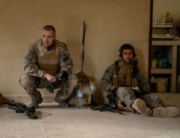There is a fascinating story within the documentary Rock in the Red Zone, about musicians and artists under constant rocket attacks in a small town in Israel, but it gets a bit lost.
American director Laura Bialis travels to the border town of Sderot, the target for homemade rockets called Quassams lobbed over from Gaza by Hamas on a daily basis. (This was filmed mostly from 2007 to 2008). Bomb shelters pepper the landscape. Some are even painted to look like colorful animals so kids feel somewhat less traumatized by having to enter them. The town is rigged with a public alert system that gives residents about 15 seconds to take cover. It’s a fairly horrific scenario, yet Sderot is awash in art and particularly music.
Bialis does some good work describing the history of the town and how non-European Jews arriving in Israel, from North Africa and the Middle East, were shepherded out there beginning in the 1950s. And a couple of experts provide background on the type of trauma that occurs in these given circumstances. One states, “There is not post trauma because the trauma is continual.”
Bialis mostly focuses on a few musicians: Hagit Yaso, whose parents are from Ethiopia; the Teapacks (a potent combo reminiscent of a mad cross between Men at Work and Gogol Bordello); and singer/songwriter Micha Biton. Eventually her focus narrows down to one: Avi Vaknin. He is clearly a gentle soul who becomes our mirror to life in the town of around 20,000. He feels a strong connection and cannot conceive of leaving as Sderot is his artistic source. Other musicians and artists echo that sentiment.
A major theme becomes how resilience breeds creativity. As the rockets increase in frequency, eventually seriously wounding an eight-year-old boy, the stubbornness to stay becomes tested. There are some intense scenes, including one with a woman having a convulsive panic attack in a bomb shelter, but these are contrasted with moments of great joy. This is clearly a place of extremes.
Bialis’s heavy-handed narration occasionally intervenes, but you can grit your teeth and bear it until about halfway when Avi turns the camera around and proclaims his love for Bialis as she is shyly shooing him away. From here on in, Bialis parallels their growing love with the growing intensity of the Gaza rockets until it culminates with Bialis and Vaknin’s wedding and the Israeli retaliation to the bombing. Guess which thread gets almost as much air time?
Look, I’m happy for Bialis, but her insistence that her personal story share the narrative is a distraction from the more compelling scenes of life on the frontline. I am sure that she feels the connection to Sderot very strongly, but her attempts to communicate this come off as insubstantial in comparison to what’s happening around her.







Leave A Comment